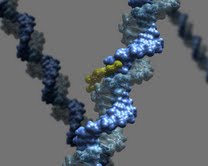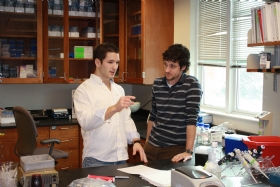Professor Daniel G. Gurnon
May 10, 2010
 Daniel “Dan” G. Gurnon, assistant professor of chemistry and biochemistry, focuses his research on visualizing the submicroscopic world. “Life at the molecular level is immensely complicated and ridiculously small,” he says. “In fact, the molecules that make life possible are tinier than a wavelength of visible light – and by definition, impossible to see. At that level of magnification, color, as we understand it, has no meaning.
Daniel “Dan” G. Gurnon, assistant professor of chemistry and biochemistry, focuses his research on visualizing the submicroscopic world. “Life at the molecular level is immensely complicated and ridiculously small,” he says. “In fact, the molecules that make life possible are tinier than a wavelength of visible light – and by definition, impossible to see. At that level of magnification, color, as we understand it, has no meaning.
“To help us understand life scientifically, we come up with representations of things such as DNA – models that can be beautiful and informative to help us imagine the un-seeable. We have to explain what molecules look like and how they behave if we’re going to understand them. For example, understanding the molecules involved in a disease can help us develop methods to treat or cure that disease."
One research project that Gurnon is working on is developing and expanding the tools used to envision biochemicals. “Molecular modeling, 3D projection and computer animation can add so much to the traditional blackboard approach to teaching,” he says. “The challenge is to create visualizations that are accurate, informative and interesting – even beautiful and inspiring – all at the same time.” Gurnon says that one aspect of the traditional approach to teaching biochemistry – drawing a molecule on a chalkboard – contains a lot of information, but it’s not particularly exciting or inspiring. By wearing 3D glasses and using a special projector, you enhance the illusion of depth and gain a better sense of the molecules you're learning to draw. "There's an awe-factor involved with the cooler 3D images," he says. "Learning to draw 2D representations of molecules is like learning the vocabulary of a new language. You need the basics of expression to communicate your ideas, but the basics can be tedious. Molecular modeling and animation can be like hearing a song in that language. It inspires you to learn more."
Gurnon says that one aspect of the traditional approach to teaching biochemistry – drawing a molecule on a chalkboard – contains a lot of information, but it’s not particularly exciting or inspiring. By wearing 3D glasses and using a special projector, you enhance the illusion of depth and gain a better sense of the molecules you're learning to draw. "There's an awe-factor involved with the cooler 3D images," he says. "Learning to draw 2D representations of molecules is like learning the vocabulary of a new language. You need the basics of expression to communicate your ideas, but the basics can be tedious. Molecular modeling and animation can be like hearing a song in that language. It inspires you to learn more."
In his second project, Gurnon and his students are studying a molecule called Tax, a protein implicated in the onset of virally induced adult T-cell leukemia. “Tax behaves differently than a typical protein,” he says. “While most proteins are able to bind to only a handful of other molecules inside a cell, Tax can grab on to more than a hundred proteins that we know of. So it’s hard to picture what’s going on there. “Scientists think this promiscuous behavior is linked to Tax's ability to interfere with cell growth. If we could explain how Tax binds to so many different molecules, we might have a strategy to block its action. However, no one knows what Tax looks like. We're trying to find out using a number of techniques to uncover the structure of something no light microscope could ever see. It's a lot of work to isolate a protein, but what we learn could someday help a lot of people.”
“Scientists think this promiscuous behavior is linked to Tax's ability to interfere with cell growth. If we could explain how Tax binds to so many different molecules, we might have a strategy to block its action. However, no one knows what Tax looks like. We're trying to find out using a number of techniques to uncover the structure of something no light microscope could ever see. It's a lot of work to isolate a protein, but what we learn could someday help a lot of people.”
Gurnon and his students are working on isolating the protein. “In biochemistry, in order to characterize a protein, you first need to purify it, and that can be a difficult process,” he says. “Once it’s pure, we’ll do some experiments designed to tell us something about the structure.”
There are other scientists who are working on this protein to see how it behaves in a cell, but no one has done the kind of study that Gurnon and his students are doing – which is to look at the protein in isolation. “This is where I think we could make a significant contribution,” he says.
Gurnon became intrigued by Tax a few years ago. He discovered that the protein binds to another type of protein that he was working on at the time. “I was reading an article about coiled-coil proteins, rope-like molecules that can tie things together in a cell. Tax binds to coiled-coils, among other proteins. My students, Zachary "Zach" T. Berndsen '10 and Graham D. Williams '10, and I were talking about it, and we couldn't understand how Tax could recognize so many different molecules. We wanted to find out."
This summer, four students are working with Gurnon to continue the ongoing research. “We need more preliminary data. If you’re going to study a protein, you have to get the gene for the protein and produce the protein using an organism like bacteria. Then you need to purify it, get by itself. We’re still struggling with that step, but we’re almost there.”
In January 2011, Gurnon will accompany 19 DePauw students on a medical outreach service trip to Tena, Ecuador. The team is collaborating with the Timmy Foundation. The students will spend 15 days in rural Ecuador traveling by bus and by boat assisting the Foundation’s medical team at clinics in underserved communities near Tena.
The Foundation’s Web site states: “The Timmy Foundation was founded in 1997 by Dr. Charles Dietzen (Dr. Chuck), an Indianapolis-based pediatric physical medicine and rehabilitation specialist. After working with Mother Teresa in Calcutta in 1996, Dr. Chuck was inspired to broaden his commitment to serving children in an international setting and empower others to do the same.
The foundation was named for Timmy, Dr. Chuck’s older brother, who passed away during infancy. The name is a tribute to both his family and children everywhere who all deserve the right to healthy futures."